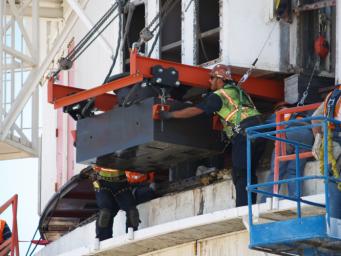
|
Removing Pads from Antenna
- Click the image above for a larger view
- Full-Res JPEG (3264 x 2448) (653.3 kB)
- Full-Res TIFF (3264 x 2448) (24.0 MB)
Caption:
On May 3, 2010, workers at the Deep Space Network's Goldstone Deep Space Communications Complex removed one of the large steel pads that help the giant "Mars antenna" rotate sideways. The pad is part of the hydrostatic bearing assembly, which distributes about 3 million kilograms (7 million pounds) on three pads and floats the structure on a film of oil as it rotates around a large steel ring. The ring is about 2.4 meters (8 feet) in diameter. Each pad weighs about 6,400 kilograms (14,000 pounds).
The removal of the pads was part of a major refurbishment of the Mars antenna that lasted from March to October 2010. During the refurbishment, both the hydrostatic bearing assembly and the elevation bearings (which enable the antenna to tip up and down from the horizon) were replaced. The 70-meter-wide (230-foot-wide) Mars antenna got its nickname from its first task: tracking the Mariner 4 spacecraft after its historic flyby of Mars in 1966. The antenna's official name is Deep Space Station 14.
Background Info:
JPL, a division of the California Institute of Technology in Pasadena, manages the Deep Space Network for NASA Headquarters, Washington. More information about the Deep Space Network is online at http://deepspace.jpl.nasa.gov/dsn/index.html .
Cataloging Keywords:
| Name | Value | Additional Values |
|---|---|---|
| Target | Earth | Mars |
| System | ||
| Target Type | Planet | |
| Mission | Deep Space Network (DSN) | Mariner |
| Instrument Host | Goldstone Deep Space Communications Complex (GDSCC) | |
| Host Type | Ground-Based Observatory | Flyby Spacecraft |
| Instrument | Deep Space Station 14 | Goldstone Solar System Radar |
| Detector | ||
| Extra Keywords | Color, Radar, Radio, Rotation | |
| Acquisition Date | ||
| Release Date | 2010-11-03 | |
| Date in Caption | 2010-05-03 | |
| Image Credit | NASA/JPL-Caltech | |
| Source | photojournal.jpl.nasa.gov/catalog/PIA13429 | |
| Identifier | PIA13429 | |
